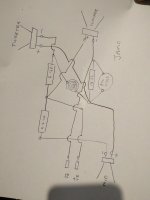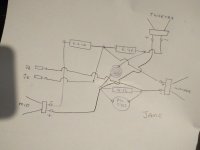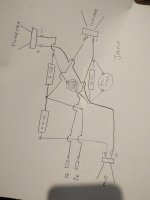If I may be so bold as to speak for Jon, then by 'more pleasing to the ear' I think he means 'compressed'. Compression is not desirable, but during an overload it is preferable to a distorted then ruined tweeter.
By 'Removal will make the tweeter respond as though it is not working', I think he is stressing that if you simply remove the polyswitch, you will break the circuit path and the tweeter will stop working. That is why I tell you to replace the polyswitch with a short length of wire.
Thanks for clarifying that.
Certainly wouldn't like compressed sound.
And, as I won't be abusing my speakers the lack of overload protection shouldn't be a problem.
I'll take the polyswitches out and run a wire in their place. Solves any issues, especially if they've already defaulted to a compressed state.
My Gale GS401's incorporate fuses.
Maybe this is a more favorable way of protecting Loudspeakers?
The trouble with fuses is that they do not automatically reset and have to be replaced when blown, which usually means dismantling the speaker.My Gale GS401's incorporate fuses.
Maybe this is a more favorable way of protecting Loudspeakers?
There are different types of speaker protection and you may read about them here: TA Speaker Topics: Vent FAQ's
I suggest the summary given in the above link states all you really need to know:
"The best method of protecting your speakers is to know their limits and stay within them. Blown speakers tend to be more of a live sound problem than a hi-fi problem. In live performance situations speakers are routinely operated at the threshold of death for extended periods of time."
Well, they are doing their intended job!!!!Quote:
"Recently I had an MS speaker to see for fix, had an issue of volume drop as it was fed more power. It was the polyswitches."
Quote:
"When they age, especially after when they had been triggered before, they tend to duck power early."
Blowing the Tweeter will produce a more permanent and expensive type of volume drop, do you prefer that?volume drop as it was fed more power
And there´s no "aging", simply today power is CHEAP and people tend to listen at stupid high levels compared to what original designers expected.
In any case, Tweeter voice coil will stand exact same power as before, protector will trigger at exact same power level as before, just use those fine speakers sensibly.
^^^^^that.if the polyswitch is considered dubious why not consider a lamp limiter to protect the tweeter?
Both are same thing, a PTC; lamp has way shorter thermal time constant though,on the other side does not "age", either works like the first day or burns.
An extra useful feature is that they provide a visual clue.
I make loud Bass amplifiers and speakers, (think Stadium use by Heavy Metal bands) and now and then somebody rings me: "Hey Juan, when slapping I see some kind of "lightning" inside the cabinets, the speaker cloth edges become inside lighted rings on the dark stage, is something wrong?"
Last edited:
Well, they are doing their intended job!!!!
Not quite, as ideally the trip level should stay at its initial value.
Both are same thing, a PTC; lamp has way shorter thermal time constant though,on the other side does not "age", either works like the first day or burns.
An extra useful feature is that they provide a visual clue.
A disadvantage is that a lamp will cause more distortion, as due to the smaller thermal time constant, its resistance will vary more over a period of the signal. I haven't a clue if that is significant compared to the normal distortion of the loudspeaker, though.
Last edited:
A polyswitch (the subject of this thread) does suffer from 'aging'. A polyswitch which is made to operate constantly under overload conditions may no longer return to its low resistance state when cool and instead stabilise at a significantly higher resistance.And there´s no "aging"
A polyswitch (the subject of this thread) does suffer from 'aging'. A polyswitch which is made to operate constantly under overload conditions may no longer return to its low resistance state when cool and instead stabilise at a significantly higher resistance.
Is it worth replacing the polyswitch with a new one?
As I won't run ridiculous levels the replacement won't have to switch very often and maybe see me out.
It seems the polyswitch's achilles is age, and high frequency of tripping.
Only if you can source one with identical specifications. That may be problematical! Leave it alone or bypass it - nuff said!Is it worth replacing the polyswitch with a new one?
I wonder which of the six PTCs shown in your link has the same specs as the PTC C995 in Cliff's Jamos, Ric?The correct ones are easy to get - Jaycar
The correct replacement is shown here: C 995, PTC thermistors for overcurrent protection - elpro Elektronik
The exact specs of the PTC C995 are given in this TDK publication: https://www.tdk-electronics.tdk.com/inf/55/db/PTC/PTC_OC_Leaded_12V_24V_C935_C995.pdf
I share your ?, Ric.?, can you post schematic please.
13 ohm is a high resistance in this context and I would also like to see exactly where the PTC is positioned in the crossover.
Meanwhile, I agree that replacement with an identical PTC or, alternatively, 13 ohms worth of resistance are the options open to Cliff.
I'd add: Replacing it with a 24 V 5 W automotive lamp will also do, as an incandescent lamp's cold resistance usually is about one tenth of it's nominal one. A lamp's decreased time constant (in comparison with a polyswitch/PTC) doesn't matter if it protects the squawker or the tweeter.
Best regards!
Best regards!
?, can you post schematic please.
Attachments
I share your ?, Ric.
13 ohm is a high resistance in this context and I would also like to see exactly where the PTC is positioned in the crossover.
Meanwhile, I agree that replacement with an identical PTC or, alternatively, 13 ohms worth of resistance are the options open to Cliff.
I have replacement caps and resister ready to go.
Just stumped with the Thermistor issue.
Everyone is posing valid points???
A visit to Jaycar, they confirmed don't have Thermistors of the correct value.
Attachments
Now that you've finally supplied the crossover circuit, I can definitely state that the folowing is valid and I hope Ric will agree with me.Everyone is posing valid points???
In the absence of a replacement C995 PTC, you have two options:
- Leave the original PTC in circuit and leave well enough alone.
- Remove the PTC and replace it with 13 oms worth of resistance (12 ohm + 1.0 ohm ceramic resistors in series).
Note that alternative suggestions regarding using lamps and fuses to replace the PTC //18 ohm protection circuit are valid, but would need their required values to be carefully calculated in order to be effective in their protection duties. I would not go there unless you know what you are doing!
@ Allen. Cold resistance should be 13 ohm according to specs.
Should be@ Allen. Cold resistance should be 13 ohm according to specs.
Thanks Guys.
I'm really indebted for your thorough consultancy.
And yes, I'll see if I can do a resistance test.
If the Thermister has defaulted to "compressed" output, then I won't really know the cause, as this might also be due to the Tweeters, or the crossover?
So I might need to do an A & B test with Thermister in place vs removed.
I'm really indebted for your thorough consultancy.
And yes, I'll see if I can do a resistance test.
If the Thermister has defaulted to "compressed" output, then I won't really know the cause, as this might also be due to the Tweeters, or the crossover?
So I might need to do an A & B test with Thermister in place vs removed.
Last edited:
- Status
- This old topic is closed. If you want to reopen this topic, contact a moderator using the "Report Post" button.
- Home
- Loudspeakers
- Multi-Way
- Thermistor removal from crossover rebuild?


